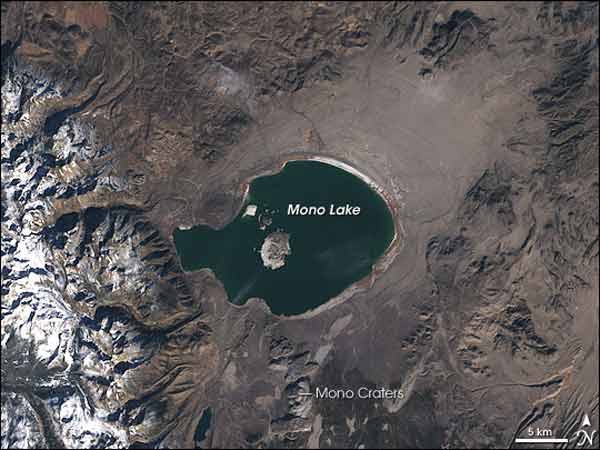
Mono Lake: Home of Arsenic-Eating Bacteria

NASA announced today that they have discovered bacteria that can survive on arsenic, even incorporating the normally poisonous substance into its DNA. The bacteria were found in California's Mono Lake.
Mono Lake is located in eastern California, along the western edge of the Great Basin, one of North America's four largest deserts. This salty remnant of a wetter era resides in a landscape of geologically young and potentially active volcanoes.
This image, captured by NASA's Landsat 7 satellite on Dec. 16, 1999, shows the lake and its surrounding area. Geologists estimate that the lake has existed for at least 760,000 years and possibly much longer.
The area immediately around the lake is relatively flat, but the terrain surrounding the lake is rugged, especially the snowcapped mountain ridges in the west. South of the lake appear some of the geologic features known as Mono Craters. Running along a roughly 10-mile (16-kilometer), north-south expanse, the Mono Craters are actually plug volcanoes (volcanoes whose previous lava flows cooled, hardened and formed domes over the vents). Geologists estimate that the Mono Craters are less than 40,000 years old.
Because Mono Lake is surrounded by mountain ranges, it has no outlet, and water entering the lake can only leave by evaporation. The water that evaporates leaves behind salts and other chemicals, so like Great Salt Lake, Mono Lake is saltier than the ocean.
Besides being salty, the lake is also "soapy" with a pH value about equal to that of household glass cleaner. The pH scale rates the acidity of liquids.
While humans should avoid drinking the water, some migratory birds find the lake appealing, and Mono Lake provides nesting habitat for California gulls.
Sign up for the Live Science daily newsletter now
Get the world’s most fascinating discoveries delivered straight to your inbox.
The newly discovered bacteria can also thrive in the lake. Felisa Wolfe-Simon and her colleagues collected the arsenic-eating bacteria from the shores of Mono Lake. The organism can utilize arsenic in place of phosphorus and opens new possibilities in the search for alien life.










